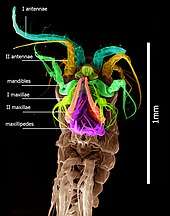Epischurella baikalensis
Epischurella baikalensis (previously Epischura baikalensis[2]) is a species of copepod in family Temoridae. It is endemic to Lake Baikal, being the dominant zooplankton species there: 80%–90% of total biomass.[3] It measures 1.5–2 mm (0.06–0.08 in).[1]
| Epischurella baikalensis | |
|---|---|
 | |
| Scientific classification | |
| Kingdom: | |
| Phylum: | |
| Subphylum: | |
| Class: | |
| Subclass: | |
| Order: | |
| Family: | |
| Genus: | Epischurella |
| Species: | E. baikalensis |
| Binomial name | |
| Epischurella baikalensis G. O. Sars, 1900; Smirnov 1936 | |
| Synonyms | |
| |

Epischurella baikalensis inhabits the entire water column, and produces two generations per year: the winter–spring and the summer. These copepods develop under different ecological conditions and vary in the duration of life stages, reproduction time, maturation of sex products and adult males and females lifespan. The total life period of the animals from each generation is one year. One female can produce 10 egg sacs every 10–20 days during its lifetime. The ratio of males and females is 1:1. One of the most essential features of the ecology of E. baikalensis is the alteration of its mass inhabited areas during a year, as well as in day time. This is due to the need for various conditions for gonad maturation, reproduction, nourishing and protection from being consumed by planktivores.
It is the Epischurella baikalensis which keeps Lake Baikal clean.[4]
Taxonomy
"Epischura baicalensis" is a misnomer common in modern literature (e.g., 13 publications in WoS/Biological abstracts since 1989 vs. none for "Epischura baikalensis"). However, the original description (Sars, 1900)[5] lists the species as Epischura baikalensis G.O.Sars, n. sp..
Recent genetic analyses of mtDNA loci resurrected Epischurella as the correct genus name (Smirnov, 1936),[2] and Epischurella baikalensis should be used in all publications.
References
- Reid, J.W. (1996). "Epischura baikalensis". IUCN Red List of Threatened Species. 1996: e.T7897A12863252. doi:10.2305/IUCN.UK.1996.RLTS.T7897A12863252.en.
- Bowman, Larry L.; MacGuigan, Daniel J.; Gorchels, Madeline E.; Cahillane, Madeline M.; Moore, Marianne V. (2019-08-08). "Revealing paraphyly and placement of extinct species within Epischura (Copepoda: Calanoida) using molecular data and quantitative morphometrics". Molecular Phylogenetics and Evolution. 140: 106578. doi:10.1016/j.ympev.2019.106578. ISSN 1055-7903. PMID 31401068.
- Пенькова О.Г. (1997). Зоопланктон в экосистеме озера Байкал (in Russian). Пробл. сохранения биол. разнообразия Юж. Сиб. : 1 Межрегион. науч.-практ. конф., Кемерово, 19-22 мая, 1997. Kemerovo: Иркутский государственный педагогический институт. p. 87. Archived from the original on 2008-04-19. Retrieved 2008-05-15.
- Peter Thomson (June 3, 2008). "Russia's Lake Baikal: Preserving a Natural Treasure". Yale Environment 360. Yale University. Archived from the original on June 13, 2010. Retrieved September 17, 2010.
- G. O. Sars (1900). "On Epischura baikalensis, a new Calanoid from Baikal Lake". Annuaire du Musée Zoologique, vol. V, pp 226-240. [L'Académie Impériale des Sciences de St.-Pétersbourg]. Missing or empty
|url=(help)
External links
- T. Chad Walter (2010). Walter TC, Boxshall G (eds.). "Epischura baikalensis Sars G.O., 1900". World of Copepods database. World Register of Marine Species.
